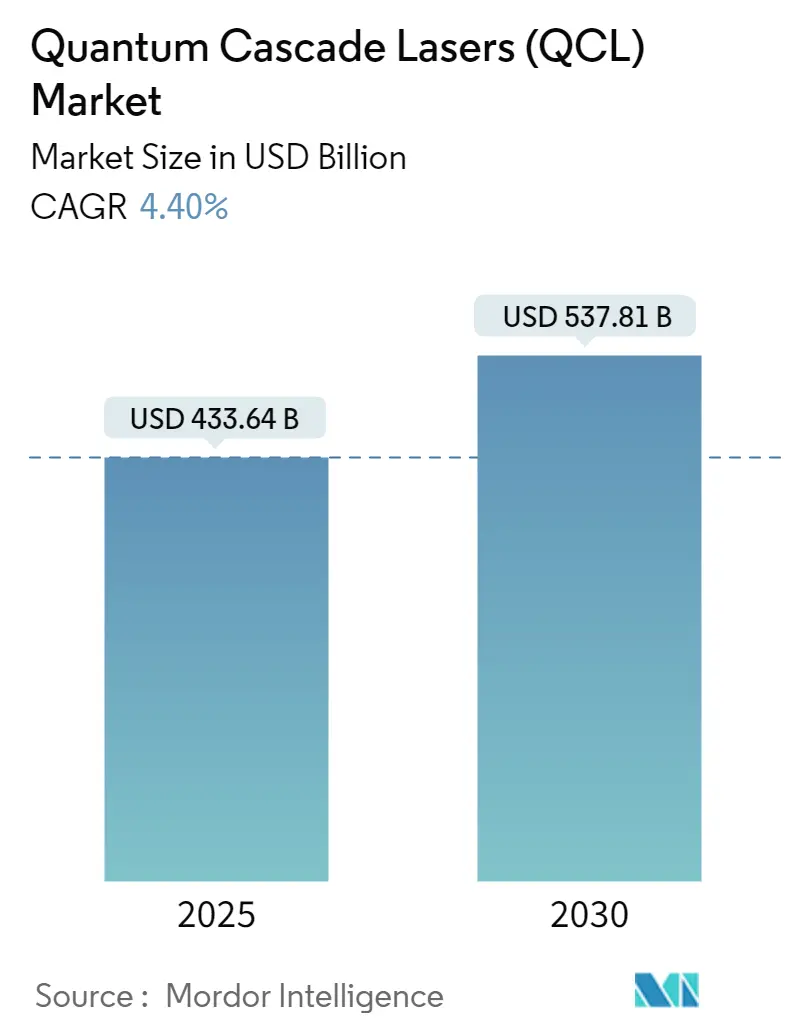
| Study Period | 2019 - 2030 |
| Market Size (2025) | USD 433.64 Billion |
| Market Size (2030) | USD 537.81 Billion |
| CAGR (2025 - 2030) | 4.40 % |
| Fastest Growing Market | Asia Pacific |
| Largest Market | Asia Pacific |
| Market Concentration | Low |
Major Players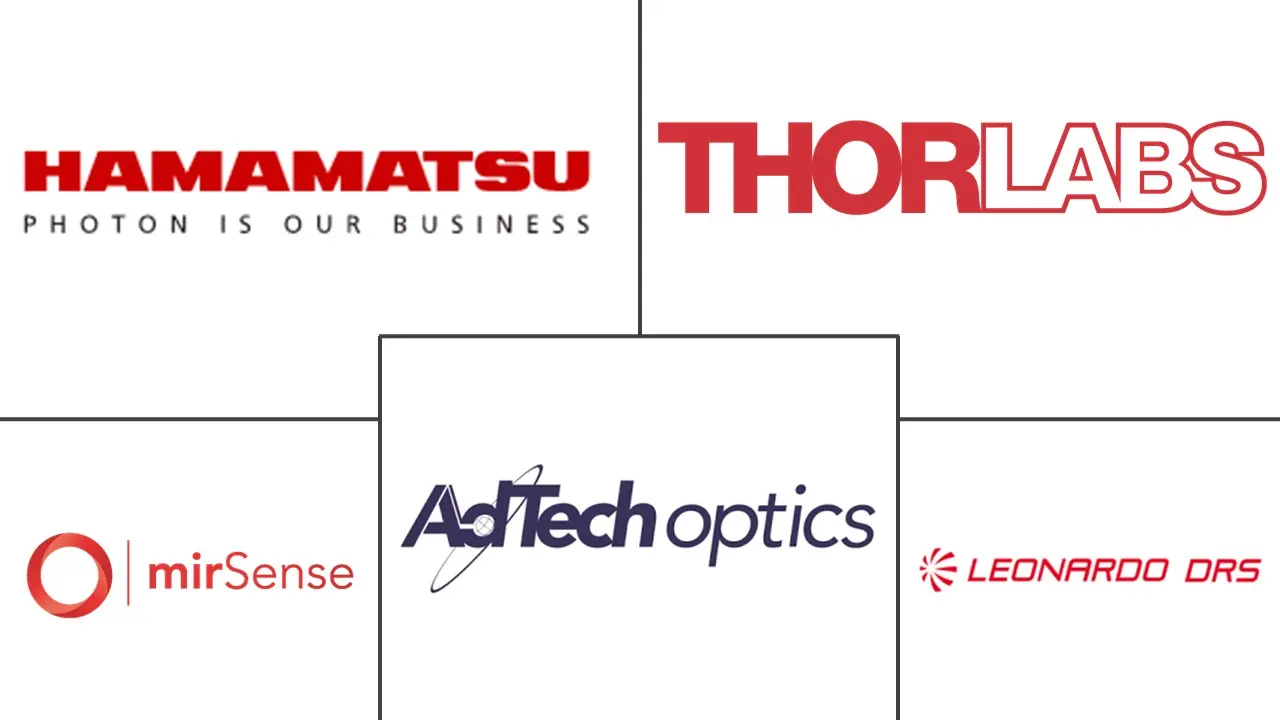
*Disclaimer: Major Players sorted in no particular order |
Quantum Cascade Lasers (QCL) Market Analysis
The Quantum Cascade Lasers Market size is estimated at USD 433.64 billion in 2025, and is expected to reach USD 537.81 billion by 2030, at a CAGR of 4.4% during the forecast period (2025-2030).
The quantum cascade lasers industry is experiencing significant transformation driven by increasing industrial automation and technological advancement across multiple sectors. According to IFR forecasts, global industrial robot installations are expected to reach approximately 518,000 units by 2024, with Asia/Australia projected to account for 370,000 units. This automation trend is particularly evident in emerging economies, where Industry 4.0 initiatives and IIoT adoption are reshaping manufacturing processes. China's industrial sector demonstrated this growth trajectory with a 4.6% increase in industrial production in 2023, reflecting the expanding implementation of advanced manufacturing technologies.
The telecommunications sector is witnessing revolutionary developments in quantum cascade laser technology applications, particularly in the realm of advanced wireless communications. These systems are being developed for millimeter-wave and terahertz communication, enabling ultra-fast, high-capacity wireless data transfer capabilities. Japan's Society 5.0 initiative exemplifies this trend, with significant investments across manufacturing (USD 77.8 million), infrastructure (USD 643.2 million), and medical sectors (USD 55 million), demonstrating the integration of IoT technology and advanced communications systems.
The semiconductor industry is experiencing substantial growth in quantum cascade laser applications, driven by increasing investments in research and development. South Korea's government has announced plans to invest a minimum of KRW 340 trillion by 2026 in semiconductor research and development, aiming to increase their global non-memory chip market share from 3% to 10% by 2030. This investment includes establishing specialized training centers and developing advanced manufacturing capabilities, reflecting the growing importance of QCL technology in semiconductor applications.
Recent strategic partnerships and technological innovations are reshaping the competitive landscape. In January 2024, Thorlabs and IRsweep entered a Licensing and Technology Transfer Agreement to extend Mid-IR spectral sensing platforms into new applications, combining conventional broadband spectrum capabilities with tunable laser flexibility. Similarly, in October 2023, Block Engineering launched next-generation compact quantum cascade lasers offering six-fold increases in laser power and enhanced thermal stability, demonstrating the industry's commitment to advancing QCL technology capabilities.
Quantum Cascade Lasers (QCL) Market Trends
Growing Need for Precision in Medical Activities
The healthcare sector's increasing demand for precise diagnostic and treatment capabilities has become a significant driver for quantum cascade laser adoption. QCLs are rapidly being utilized in medical diagnostics for breath analysis, non-invasive spectroscopy, and disease diagnosis, delivering precise and accurate measurements for applications like blood glucose monitoring and cancer biomarker detection. According to the American Cancer Society, in 2024, an estimated 2,001,140 new cancer cases and 611,720 cancer deaths are projected to occur in the United States, highlighting the critical need for advanced diagnostic technologies.
The aging population and increasing prevalence of chronic diseases are further accelerating the adoption of QCL-based medical technologies. In Germany, the population of 60 years and older is expected to reach 37.6% by 2050, while in Japan, approximately 29% of the total population was aged 65 years and older in 2022. This demographic shift is driving investment in advanced medical imaging and diagnostic equipment, particularly in applications such as non-invasive glucose monitoring and spectroscopic analysis for disease detection and treatment monitoring. The technology's ability to provide high-resolution infrared spectroscopy and precise control of emission wavelengths makes it particularly valuable for early disease detection and monitoring.
Increased Demand for Gas Sensing and Chemical Detection Applications in the Military and Defense
The military and defense sector's growing emphasis on advanced detection and surveillance capabilities has significantly driven the demand for quantum cascade lasers. According to SIPRI, military expenditures in North America reached more than 900 billion US dollars in 2022, with East Asia spending almost 400 billion US dollars, creating substantial opportunities for QCL technology deployment. These lasers play a vital role in various military applications, including remote sensing, infrared countermeasure systems, chemical sensing applications, laser target designation, and directed energy weapons.
Recent developments in military applications demonstrate the expanding role of QCL technology. In October 2023, BIRD showcased its advanced SPREOS DIRCM solution at AUSA's annual meeting, featuring QCL technology for missile protection systems. The system utilizes advanced dual-band quantum cascade lasers for accurate threat assessment and countermeasures. Additionally, in March 2023, Block Engineering secured a USD 2.2 million contract from the Naval Surface Warfare Center Indian Head Division for developing advanced spectrometer systems using proprietary QCLs, highlighting the increasing military investment in this technology. The Indian government has also set ambitious defense production targets of USD 25 billion by 2025, including USD 5 billion from exports, further driving the demand for advanced detection and sensing technologies.
Segment Analysis: By Type
Distributed Feedback Lasers Segment in Quantum Cascade Lasers Market
The Distributed Feedback Lasers segment dominates the global quantum cascade lasers market, holding approximately 58% market share in 2024. These semiconductor lasers are extensively utilized in telecommunications due to their smooth and adjustable wavelength control, low noise, and narrow spectral width characteristics. The segment's prominence is driven by its widespread adoption in optical communication applications, particularly in DWDM optical fiber multiplexing technology, where tunable laser signals are essential. Distributed feedback lasers have become increasingly important in medical applications, from modest soft tissue treatments to spectroscopic and photosensitizer treatments, owing to their small size, cost-effectiveness, and ease of use. Their application in biophotonics, including fluorescence microscopy, flow cytometry, and DNA sequencing, further strengthens their market position.
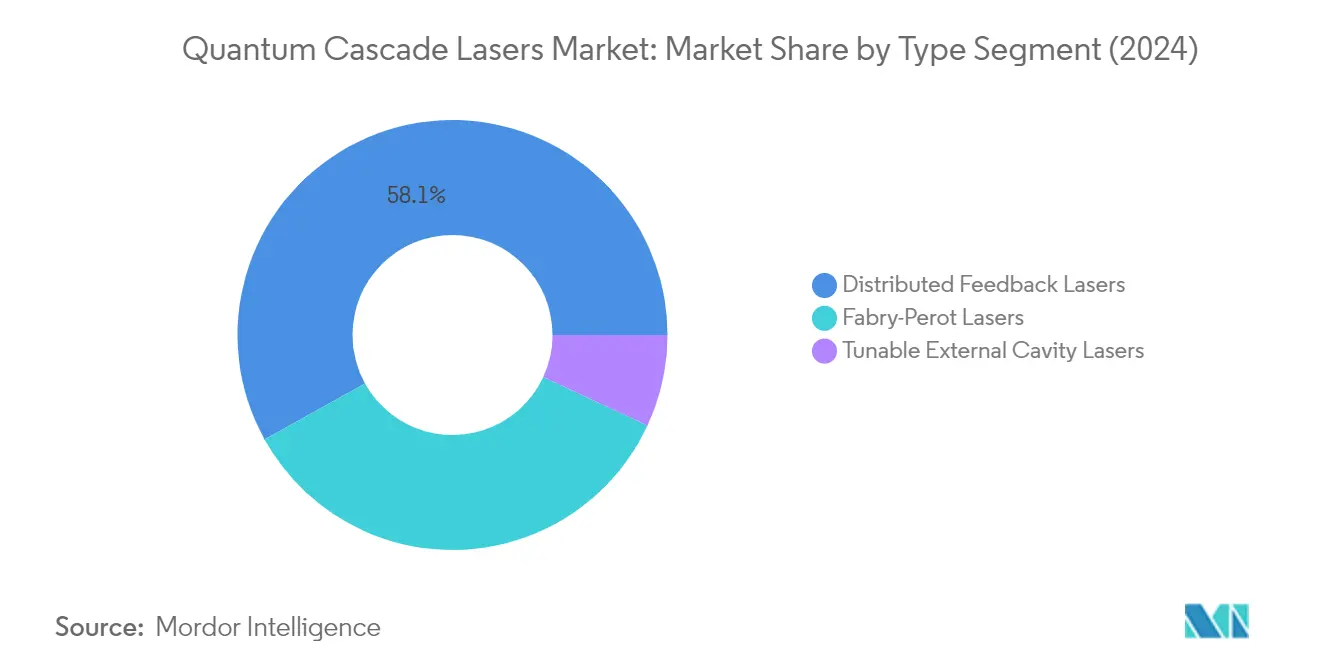
Tunable External Cavity Lasers Segment in Quantum Cascade Lasers Market
The Tunable External Cavity Lasers segment is projected to exhibit the highest growth rate of approximately 6% during the forecast period 2024-2029. This growth is attributed to their unique capability to combine quantum cascade laser chips with external cavities, typically consisting of diffraction gratings, mirrors, and adjustable elements like piezoelectric actuators. These photonic devices offer significant advantages in infrared spectroscopy and sensing applications where specific absorption or emission lines must be targeted. The segment's growth is further supported by their ability to deliver continuous mode-hop-free tuning, stability, and narrow linewidth characteristics. The future of tunable external cavity lasers is characterized by ongoing innovation to expand their capabilities, improve performance, and broaden their range of applications.
Remaining Segments in Quantum Cascade Lasers Market by Type
The Fabry-Perot Lasers segment represents a significant portion of the quantum cascade lasers market, offering unique advantages in various applications. These lasers are particularly valuable for low-data-rate short-distance transmission and serve as essential components in optical transmission, data communication, and local optical networks. Fabry-Perot lasers are distinguished by their wide spectrum width and multi-longitudinal mode characteristics, making them suitable for applications where these features are advantageous over single-mode operation. Their ability to work with low threshold and operating current across different operational temperature ranges makes them versatile solutions for diverse industrial applications.
Segment Analysis: By Operation
Continuous Wave Segment in Quantum Cascade Lasers Market
The Continuous Wave segment dominates the global quantum cascade lasers market, commanding approximately 60% of the market share in 2024. This significant market position is attributed to the segment's superior stability and reliability in various applications, particularly in infrared spectroscopy, sensing, telecommunications, and material processing. Continuous wave QCLs provide constant beam intensity over time, making them ideal for applications requiring precise and uninterrupted laser emission. The segment's prominence is further strengthened by its extensive use in high-precision manufacturing processes, environmental monitoring, and medical diagnostics, where stable and continuous laser output is crucial for accurate measurements and analysis. Additionally, the growing adoption of continuous wave QCLs in industrial process control and quality assurance applications, coupled with their ability to achieve higher spectral resolution and sensitivity, continues to drive their market dominance.
Pulsed Wave Segment in Quantum Cascade Lasers Market
The Pulsed Wave segment is emerging as the fastest-growing segment in the quantum cascade lasers market, projected to grow at a CAGR of approximately 6% during the forecast period 2024-2029. This accelerated growth is driven by the segment's unique advantages in applications requiring high peak powers and reduced thermal load. Pulsed QCLs are increasingly being adopted in advanced sensing applications, particularly in military and defense sectors for infrared countermeasures and remote sensing operations. The segment's growth is further fueled by its expanding applications in laser-induced breakdown spectroscopy, time-resolved laser spectroscopy, and range finding systems. The ability of pulsed QCLs to achieve higher peak powers while maintaining lower average power consumption makes them particularly attractive for portable and battery-operated devices, contributing to their rapid market expansion. Additionally, ongoing technological advancements in pulse generation and control mechanisms are opening new opportunities for pulsed QCLs in emerging applications.
Segment Analysis: By End-User Industry
Industrial Segment in Quantum Cascade Lasers Market
The industrial segment continues to dominate the quantum cascade lasers market, holding approximately 35% market share in 2024. This significant market position is driven by the extensive adoption of QCLs in various industrial applications including gas sensing, chemical detection, and process control monitoring. The segment's prominence is further strengthened by the increasing implementation of Industry 4.0 technologies and the growing demand for industrial environmental monitoring, particularly in emerging economies like China, India, and South Korea. The industrial sector's leadership is also attributed to the rising automation trends in manufacturing processes, with QCL lasers playing a crucial role in quality control, safety systems, and precision manufacturing applications. The segment's robust performance is supported by various government initiatives promoting smart manufacturing and industrial digitization across different regions, particularly in Asia-Pacific countries where manufacturing sectors are experiencing significant growth and technological transformation.
Telecommunication Segment in Quantum Cascade Lasers Market
The telecommunication segment is emerging as the fastest-growing sector in the quantum cascade lasers market, with a projected growth rate of approximately 7% during the forecast period 2024-2029. This remarkable growth is primarily driven by the increasing adoption of QCLs in free-space optical communication systems and specialized telecommunications applications. The segment's expansion is further fueled by ongoing research into QCL applications for fiber-optic communications systems, particularly in niche applications where their unique characteristics offer distinct advantages over traditional laser sources. The growth is also supported by significant government initiatives worldwide to boost telecommunication sector development, including investments in 5G and 6G evolution. The segment's rapid advancement is particularly notable in regions with ambitious digital connectivity goals, where QCL technology is being explored for high-speed data transmission and secure communication networks.
Remaining Segments in End-User Industry
The quantum cascade lasers market encompasses several other significant segments including medical, military and defense, food and beverage, and other end-user industries. The medical segment is particularly noteworthy for its applications in breath analysis, non-invasive glucose monitoring, and spectroscopic analysis for disease detection. The military and defense sector utilizes QCLs for remote sensing, infrared countermeasure systems, and chemical detection applications. The food and beverage industry employs QCLs for quality control, safety monitoring, and authentication processes. Other end-user industries, including automotive and environmental monitoring, contribute to the market's diversity through applications in emission monitoring, climate research, and various sensing applications. Each of these segments plays a vital role in driving innovation and adoption of QCL technology across different applications and use cases.
Quantum Cascade Lasers Market Geography Segment Analysis
Quantum Cascade Lasers Market in North America
North America represents a significant market for quantum cascade lasers, driven by advanced technological infrastructure and a strong presence in the defense, healthcare, and telecommunications sectors. The United States and Canada are the key contributors to the regional market, with substantial investments in research and development of QCL technologies. The region's growth is supported by the increasing adoption of QCLs in gas sensing, chemical detection, and medical diagnostic applications, along with robust defense spending and technological innovations.
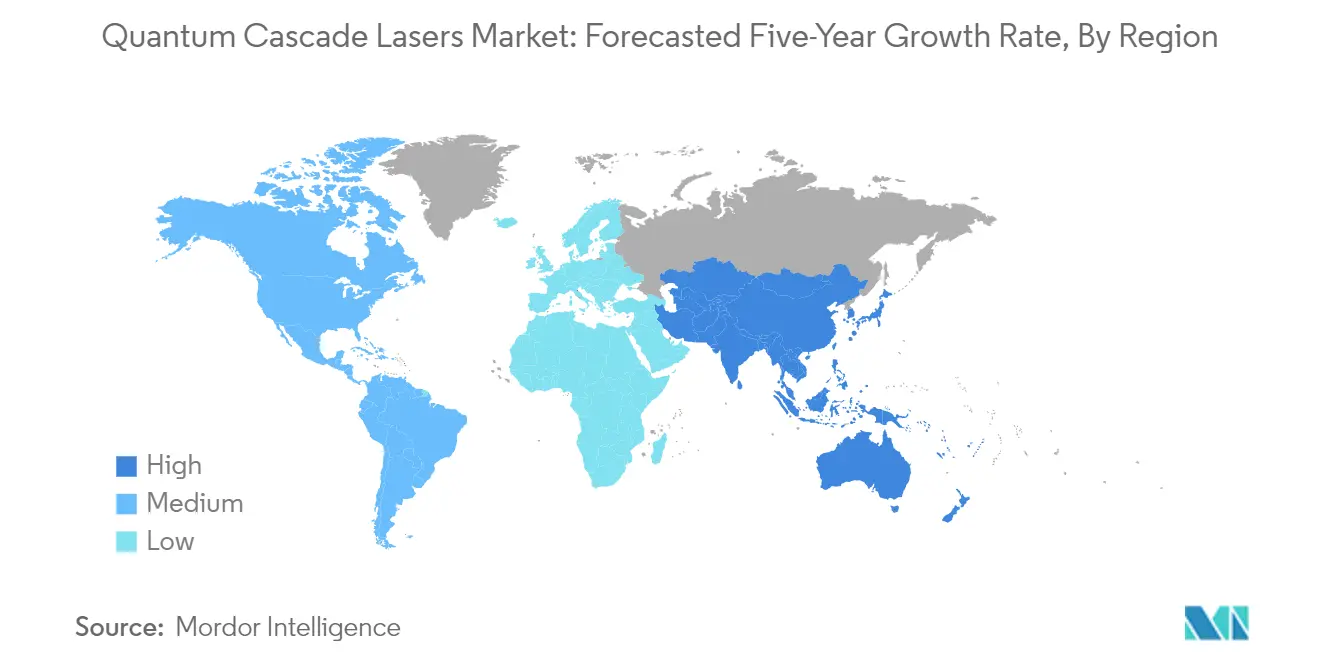
Quantum Cascade Lasers Market in United States
The United States dominates the North American quantum cascade lasers market, holding approximately 89% of the regional market share in 2024. The country's market is primarily driven by substantial investments in defense applications, medical research, and industrial automation. The US government's initiatives to boost local manufacturing through "Make in America" programs have created additional opportunities for QCL applications in industrial processes. The country's strong focus on healthcare infrastructure and the increasing adoption of advanced diagnostic technologies further support market growth, particularly in applications like non-invasive glucose monitoring and breath analysis.
Quantum Cascade Lasers Market in Canada
Canada emerges as the fastest-growing market in North America, with a projected growth rate of approximately 6% from 2024 to 2029. The country's market is driven by increasing research and development activities in quantum technologies and the growing adoption of automation solutions in manufacturing processes. Canada's commitment to advancing wireless technologies and next-generation networks, including 5G and 6G evolution, creates additional opportunities for QCL applications. The government's initiatives like the Advanced Manufacturing Partnership (AMP) and the Automate Canada program further support market expansion through increased integration of advanced technologies in manufacturing processes.
Quantum Cascade Lasers Market in Europe
Europe represents a mature market for quantum cascade lasers, characterized by strong research capabilities and technological innovation. The region's market is driven by countries including Germany, the United Kingdom, and France, each contributing significantly to market development through various industrial and research applications. The European market benefits from robust manufacturing sectors, advanced healthcare infrastructure, and an increasing focus on environmental monitoring applications, supported by various government initiatives and research programs.
Quantum Cascade Lasers Market in Germany
Germany leads the European quantum cascade lasers market, commanding approximately 28% of the regional market share in 2024. The country's dominance is attributed to its position as the largest manufacturing and processing hub in Europe, with particular strength in automotive, healthcare, and industrial applications. Germany's food processing industry and automotive sector provide substantial opportunities for QCL applications, supported by initiatives like Industry 4.0 and significant investments in research and development activities.
Quantum Cascade Lasers Market in France
France demonstrates the highest growth potential in the European market, with a projected growth rate of approximately 5% from 2024 to 2029. The country's market is driven by increasing investments in defense applications, healthcare infrastructure, and industrial automation. France's strategic focus on reindustrialization through initiatives like 'Made in France' and significant investments in technological innovation contribute to market growth. The country's commitment to advancing quantum technologies and expanding applications in various sectors positions it favorably for continued expansion.
Quantum Cascade Lasers Market in Asia-Pacific
The Asia-Pacific region represents a dynamic market for quantum cascade lasers, characterized by rapid industrialization, increasing healthcare investments, and the growing adoption of advanced technologies. The region encompasses key markets including China, Japan, South Korea, and India, each contributing uniquely to market development. The market benefits from robust manufacturing sectors, increasing healthcare expenditure, and government initiatives supporting technological advancement across various industries.
Quantum Cascade Lasers Market in China
China dominates the Asia-Pacific quantum cascade lasers market as the largest country in terms of market size. The country's market leadership is driven by extensive manufacturing capabilities, increasing healthcare expenditure, and strong government support for technological advancement. China's commitment to industrial automation, environmental monitoring, and healthcare infrastructure development creates substantial opportunities for QCL applications. The country's focus on Industry 4.0 implementation and environmental protection initiatives further supports market expansion.
Quantum Cascade Lasers Market in China - Growth Leader
China also leads the region in terms of growth rate, demonstrating the strongest market expansion potential in Asia-Pacific. The country's rapid industrial development, increasing adoption of automation technologies, and growing focus on environmental monitoring applications drive this growth. China's substantial investments in healthcare infrastructure and commitment to technological innovation in manufacturing processes support continued market expansion. The government's initiatives promoting advanced manufacturing and environmental protection further contribute to market development.
Quantum Cascade Lasers Market in Latin America
The Latin American quantum cascade lasers market demonstrates growing potential, driven by increasing industrialization and technological adoption across various sectors. The region's market development is supported by expanding manufacturing capabilities, particularly in automotive and industrial applications. Brazil and Mexico emerge as key contributors, with Brazil representing the largest market and Mexico showing the fastest growth potential. The region's focus on modernizing industrial processes and increasing adoption of advanced technologies in manufacturing and healthcare sectors continues to drive market expansion.
Quantum Cascade Lasers Market in Middle East & Africa
The Middle East & Africa region presents emerging opportunities in the quantum cascade lasers market, driven by increasing investments in industrial automation and healthcare infrastructure. The region's market growth is supported by expanding oil and gas operations, which require advanced sensing and monitoring technologies. The United Arab Emirates emerges as the largest market in the region, while Egypt demonstrates the fastest growth potential, driven by increasing investments in healthcare and industrial applications. The region's focus on diversifying economies and modernizing industrial processes continues to create new opportunities for QCL applications.
Quantum Cascade Lasers (QCL) Market Overview
Top Companies in Quantum Cascade Lasers Market
The quantum cascade lasers market features prominent players like Hamamatsu Photonics KK, Thorlabs Inc., Adtech Optics Inc., Mirsense SAS, Leonardo DRS Inc., Nanoplus Nanosystems and Technologies GmbH, Alpes Lasers S.A., and Block Engineering. These companies are heavily investing in research and development to enhance their product portfolios and maintain competitive advantages. Strategic collaborations with research institutions and government agencies have become increasingly common to accelerate innovation and expand application areas. Companies are focusing on developing customizable solutions to meet specific customer requirements while simultaneously working on improving laser efficiency, power output, and wavelength coverage. Geographic expansion through distribution networks and partnerships has emerged as a key strategy, with many players establishing a presence across multiple regions to capture diverse market opportunities. The industry has also witnessed increased emphasis on manufacturing capabilities and quality control to ensure product reliability and performance consistency.
Moderate Consolidation with Strong Regional Players
The quantum cascade laser market exhibits a moderately consolidated structure, characterized by a mix of global technology conglomerates and specialized laser manufacturers. Global players leverage their extensive research capabilities and established distribution networks to maintain market leadership, while regional specialists focus on niche applications and local market expertise. The market has witnessed strategic partnerships and collaborations rather than outright acquisitions, as companies seek to combine complementary technologies and expertise. Manufacturing capabilities and intellectual property rights play crucial roles in determining competitive positions, with established players holding significant patent portfolios that create entry barriers for new entrants.
The competitive dynamics are shaped by the presence of both vertically integrated manufacturers and specialized component suppliers. Companies with in-house manufacturing capabilities for critical components maintain better control over their supply chains and product quality. The market has seen increased collaboration between quantum cascade laser manufacturers and end-user industries, particularly in defense, healthcare, and industrial sectors, leading to more application-specific product development. Regional markets show varying levels of competition, with developed regions hosting more established players while emerging markets present opportunities for new entrants with innovative solutions.
Innovation and Customization Drive Market Success
Success in the quantum cascade lasers market increasingly depends on technological innovation capabilities and the ability to provide customized solutions for specific applications. Companies need to maintain robust research and development programs while building strong relationships with key end-user industries. Establishing partnerships with research institutions and participating in government-funded projects can provide access to cutting-edge technologies and new application areas. Market players must also focus on developing cost-effective manufacturing processes and maintaining strong quality control measures to meet the demanding requirements of industrial and medical applications. Building a comprehensive service and support network has become essential for maintaining customer relationships and ensuring long-term success.
For new entrants and smaller players, focusing on specific market niches or geographic regions offers a viable path to market success. Companies must carefully evaluate regulatory requirements across different regions and applications, particularly in medical and defense sectors, to ensure compliance and market access. The ability to provide comprehensive solutions, including software and support services, is becoming increasingly important as end-users seek integrated systems rather than standalone products. Players must also maintain flexibility in their manufacturing processes to accommodate varying customer requirements while ensuring consistent product quality. Building strong relationships with component suppliers and maintaining efficient supply chain management are crucial for maintaining competitive pricing and reliable product delivery.
Quantum Cascade Lasers (QCL) Market Leaders
-
Hamamatsu Photonics KK
-
Thorlabs Inc.
-
Adtech Optics Inc.
-
Mirsense SAS
-
Leonardo Drs Inc.
- *Disclaimer: Major Players sorted in no particular order
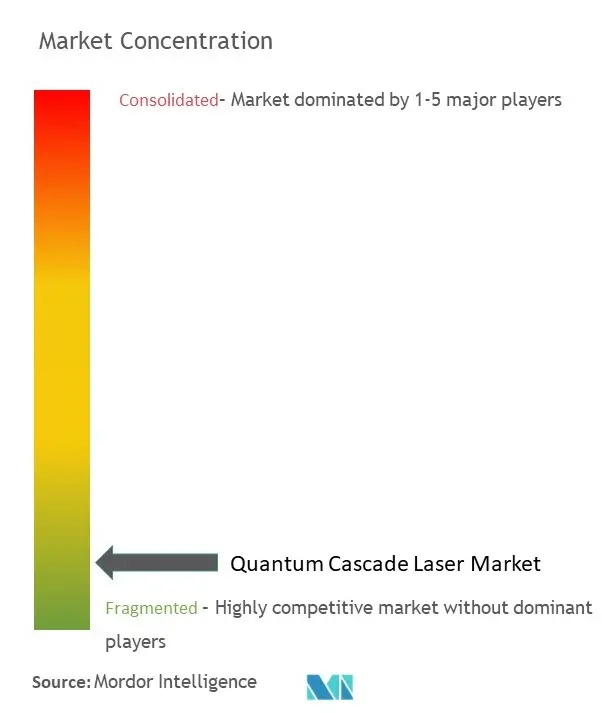
Quantum Cascade Lasers (QCL) Market News
- March 2024 - The members of the French quantum ecosystem reviewed the results of the national quantum strategy three years after its launch by President Emmanuel Macron. They also announced the launch of PROQCIMA, which aims to have two prototypes of universal quantum computers of French design by 2030. The plan is structured around strategic objectives that include the development of quantum computing, quantum sensing, quantum cryptography, and quantum communication strategies. Such initiatives may create a demand for QCL technology in the forecasted period.
- October 2023 - Nano plus Nanosystems and Technologies GmbH aimed the far-infrared with its new single-mode continuous-wave quantum cascade lasers (CW-QCL). Ultra-sensitive and custom applications benefit from target wavelengths in the 6 µm to 11 µm range. With the new CW Distributed Feedback QCLs, nanoplus complements its portfolio of high-precision DFB lasers for tunable diode laser absorption spectroscopy.
Quantum Cascade Lasers (QCL) Market Report - Table of Contents
1. INTRODUCTION
- 1.1 Study Assumptions and Market Definition
- 1.2 Scope of the Study
2. RESEARCH METHODOLOGY
3. EXECUTIVE SUMMARY
4. MARKET INSIGHTS
- 4.1 Market Overview
-
4.2 Industry Attractiveness - Porters Five Forces Analysis
- 4.2.1 Bargaining Power of Suppliers
- 4.2.2 Bargaining Power of Buyers
- 4.2.3 Threat of New Entrants
- 4.2.4 Threat of Substitutes
- 4.2.5 Intensity of Competitive Rivalry
- 4.3 Impact of COVID-19 Aftereffects and Other Macroeconomic Factors on the Market
5. MARKET DYNAMICS
-
5.1 Market Drivers
- 5.1.1 Growing Need For Precision in the Medical Activities
- 5.1.2 Increased Demand of Gas Sensing and Chemical Detection Applications in the Military and Defense
-
5.2 Market Challenges
- 5.2.1 High Up-front Associated Costs
6. MARKET SEGMENTATION
-
6.1 By Type
- 6.1.1 Fabry-Perot Lasers
- 6.1.2 Distributed Feedback Lasers
- 6.1.3 Tunable External Cavity Lasers
-
6.2 By Operation
- 6.2.1 Continuous Wave
- 6.2.2 Pulsed Wave
-
6.3 By End-user Industry
- 6.3.1 Industrial
- 6.3.2 Medical
- 6.3.3 Military and Defense
- 6.3.4 Telecommunication
- 6.3.5 Food and Beverage
- 6.3.6 Other End-user Industries
-
6.4 By Geography
- 6.4.1 North America
- 6.4.1.1 United States
- 6.4.1.2 Canada
- 6.4.2 Europe
- 6.4.2.1 United Kingdom
- 6.4.2.2 Germany
- 6.4.2.3 France
- 6.4.3 Asia
- 6.4.3.1 China
- 6.4.3.2 Japan
- 6.4.3.3 South Korea
- 6.4.3.4 India
- 6.4.4 Australia and New Zealand
- 6.4.5 Latin America
- 6.4.6 Middle East and Africa
7. COMPETITIVE LANDSCAPE
- 7.1 Vendor Positioning Analysis
-
7.2 Company Profiles*
- 7.2.1 Hamamatsu Photonics KK
- 7.2.2 Thorlabs Inc.
- 7.2.3 Adtech Optics Inc.
- 7.2.4 Mirsense SAS
- 7.2.5 Leonardo Drs Inc.
- 7.2.6 Nanoplus Nanosystems and Technologies GmbH
- 7.2.7 Inphenix Inc.
- 7.2.8 Alpes Lasers SA
- 7.2.9 Sacher Lasertechnik Gmbh
- 7.2.10 Block Engineering Inc.
8. INVESTMENT ANALYSIS
9. FUTURE OF THE MARKET
Quantum Cascade Lasers (QCL) Market Industry Segmentation
The quantum cascade lasers (QCLs) market is defined by the revenue generated from the sale of quantum cascade lasers offered by different market players for a diverse range of end-user industries. The market trends are evaluated by analyzing the investments made in product innovation, diversification, and expansion. Furthermore, the advancements in the telecommunications, medical, and manufacturing sectors are crucial in determining the growth of the market studied.
The quantum cascade laser market is segmented by type (fabry-perot lasers, distributed feedback lasers, tunable external cavity lasers), by operation (continuous wave, pulsed wave), by end-user industry (industrial, medical, military and defense, telecommunication, food and beverage, other end-user industries), by geography (North America [United States, Canada], Europe [United Kingdom, Germany, France, Rest of Europe], Asia-Pacific [China, Japan, South Korea, India, Rest of Asia-Pacific], Latin America, Middle East and Africa). The market sizes and forecasts are provided in terms of value in USD for all the above segments.
| By Type | Fabry-Perot Lasers | ||
| Distributed Feedback Lasers | |||
| Tunable External Cavity Lasers | |||
| By Operation | Continuous Wave | ||
| Pulsed Wave | |||
| By End-user Industry | Industrial | ||
| Medical | |||
| Military and Defense | |||
| Telecommunication | |||
| Food and Beverage | |||
| Other End-user Industries | |||
| By Geography | North America | United States | |
| Canada | |||
| Europe | United Kingdom | ||
| Germany | |||
| France | |||
| Asia | China | ||
| Japan | |||
| South Korea | |||
| India | |||
| Australia and New Zealand | |||
| Latin America | |||
| Middle East and Africa | |||
Quantum Cascade Lasers (QCL) Market Research FAQs
How big is the Quantum Cascade Lasers Market?
The Quantum Cascade Lasers Market size is expected to reach USD 433.64 billion in 2025 and grow at a CAGR of 4.40% to reach USD 537.81 billion by 2030.
What is the current Quantum Cascade Lasers Market size?
In 2025, the Quantum Cascade Lasers Market size is expected to reach USD 433.64 billion.
Who are the key players in Quantum Cascade Lasers Market?
Hamamatsu Photonics KK, Thorlabs Inc., Adtech Optics Inc., Mirsense SAS and Leonardo Drs Inc. are the major companies operating in the Quantum Cascade Lasers Market.
Which is the fastest growing region in Quantum Cascade Lasers Market?
Asia Pacific is estimated to grow at the highest CAGR over the forecast period (2025-2030).
Which region has the biggest share in Quantum Cascade Lasers Market?
In 2025, the Asia Pacific accounts for the largest market share in Quantum Cascade Lasers Market.
What years does this Quantum Cascade Lasers Market cover, and what was the market size in 2024?
In 2024, the Quantum Cascade Lasers Market size was estimated at USD 414.56 billion. The report covers the Quantum Cascade Lasers Market historical market size for years: 2019, 2020, 2021, 2022, 2023 and 2024. The report also forecasts the Quantum Cascade Lasers Market size for years: 2025, 2026, 2027, 2028, 2029 and 2030.
Our Best Selling Reports
Quantum Cascade Lasers (QCL) Market Research
Mordor Intelligence provides comprehensive insights into the quantum cascade lasers market, offering detailed industry analysis, market forecasts, and strategic evaluations of key players in the semiconductor manufacturing industry. Our research encompasses crucial developments in laser technology, optical sensing, and infrared spectroscopy, with particular focus on emerging applications in trace gas detection and defense sectors. The report pdf delivers actionable intelligence on market segmentation, competitive landscape, and growth opportunities, enabling stakeholders to make informed decisions in this rapidly evolving semiconductor laser space.
Beyond market research, our consulting expertise extends to technology scouting and R&D analysis, helping businesses navigate the complexities of quantum cascade laser technology implementation. We provide detailed assessments of emerging applications in photonic integrated circuits and optoelectronic devices, along with comprehensive analysis of customer needs and behavior patterns. Our team specializes in identifying and evaluating potential partners and distributors, conducting B2B surveys, and offering strategic insights for new product launches in the industrial laser market. Through data aggregation and advanced visualization techniques, we help clients understand market dynamics and capitalize on emerging opportunities in the semiconductor manufacturing sector.




